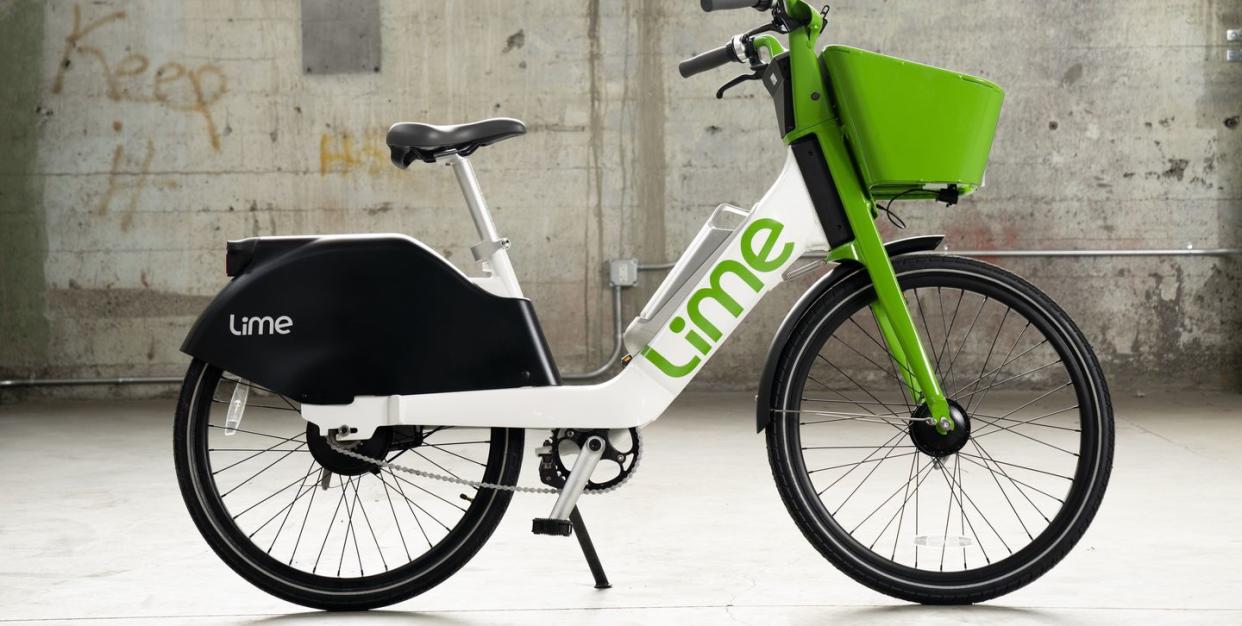Lime Invested $50 Million Into Its E-Bike Share, and Plans to Expand to 50 Cities By the End of 2021

Lime recently announced a $50 million investment into e-bikes, planning to expand its fleet across the nation and the globe.
The e-bike and e-scooter rideshare company is also introducing a new model of e-bike. The biggest change is an easier-to-maintain battery that can be used interchangeably on the e-bikes and the e-scooters.
Lime is betting big on e-bikes—$50 million to be exact.
The e-bike and e-scooter rideshare company announced the major investment on March 1, which was spurred by reaching its “first full quarter of profitability in 2020,” according to a Lime press release.
🚨 If you love riding, then you’ll love Bicycling All Access. Come join us! 🚲
Lime currently has e-bikes in 10 U.S. markets, and it’s looking to expand that to 20 to 25 U.S. markets, according to Lime’s communications director Russell Murphy. Globally, Lime e-bikes are currently in 26 markets; the new goal is 50 cities across the world.
“E-bikes are something that we’re eager to bet on,” Murphy told Bicycling.
The new e-bike investment marks a big change from what Lime was doing previously. In early 2019, the rideshare had largely shifted its focus to e-scooters, and by early 2020, it had even phased out most of its bikes, according to Murphy. But Lime then acquired the Jump bike share from Uber last May, putting them back into the bike business.
The COVID-19 pandemic has triggered a bike boom as people sought out safer ways to commute or spend their downtime. Lime has seen a “tremendous jump” in e-bike use, according to Murphy. Plus the average e-bike ride distance nearly doubled, and Lime has seen an increase in the number of new riders using its bike share.
“Probably as a response to the pandemic, people flocked to e-bikes,” Murphy said. “Especially for essential workers, it became one of the safest and easiest ways to get around.” He also noted that tourists and commuters make up a large part of Lime’s ridership.
Lime also unveiled its new model, the 6.0 e-bike, with some significant upgrades. The most notable one is the battery, which is now interchangeable with the battery on its e-scooters. The design improvement and new compatibility between the two modes of transportation, Murphy said, will make them easier to maintain and require less trips out into the field for Lime’s technicians.
The sustainability, or lack thereof, of such bike shares came into focus last year when Lime acquired Jump from Uber. Instead of donating or reusing the e-bikes, which would have been a liability, Uber sent thousands of older models to be recycled. While Murphy couldn’t cite a specific lifespan for Lime’s new e-bikes, he did say, “Our newer bikes will last longer than our current bikes.”
Other upgrades include:
A phone holder to help make navigating easier
Increased motor power to make tackling hills even easier
An automatic two-speed transmission
An electric lock instead of the old cable lock
A standardized handlebar display that matches the one on Lime’s e-scooters
Lime isn’t giving up on e-scooters either and will continue to expand those markets as well. In fact, Murphy said that e-scooter use went up in markets where Lime added e-bikes.
“We’re always looking to expand our e-scooter business,” Murphy said. “The value is having both modes together in the same city.” E-scooter trips account for more rides between 0.5 and 1.5 miles in distance, while e-bike rides are typically longer. Lime passes—which are daily, weekly, or monthly—can be used for both modes.
The 6.0 e-bike will be introduced to markets across North America, Europe, Australia, and New Zealand this summer. Lime will also be introducing mopeds to certain markets (similar to Revel mopeds, Murphy says) in the coming weeks, starting in Washington, D.C. and then Paris.
You Might Also Like

